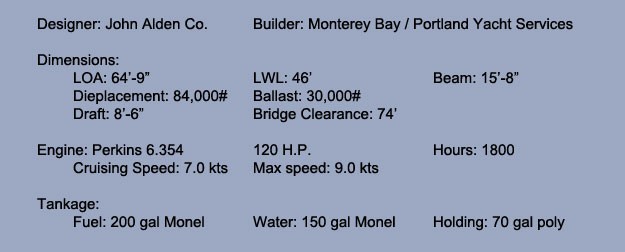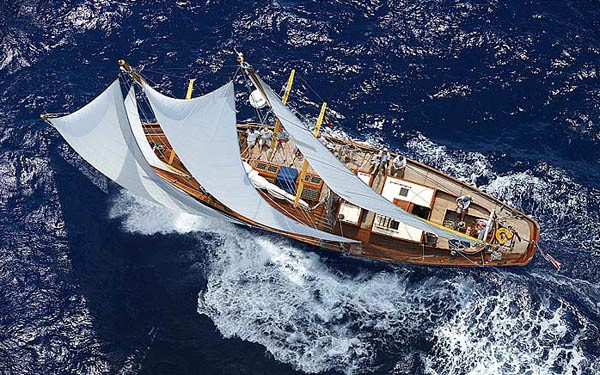
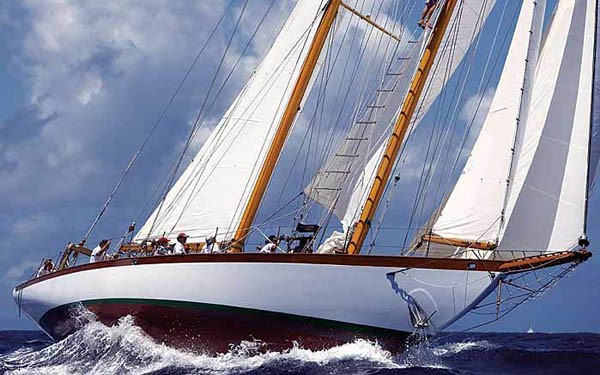
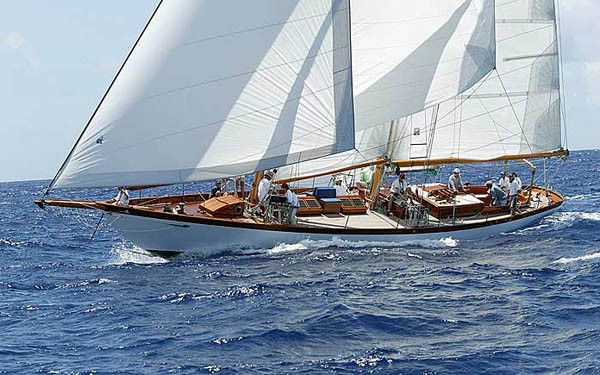
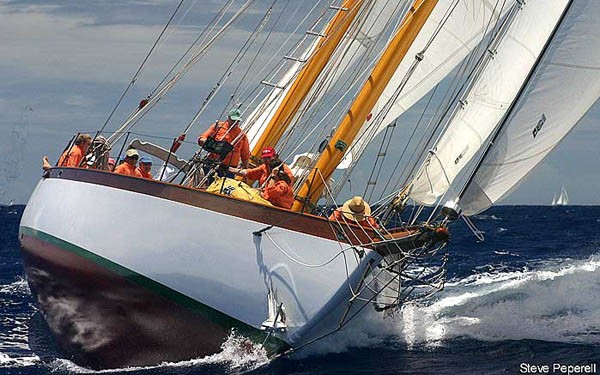
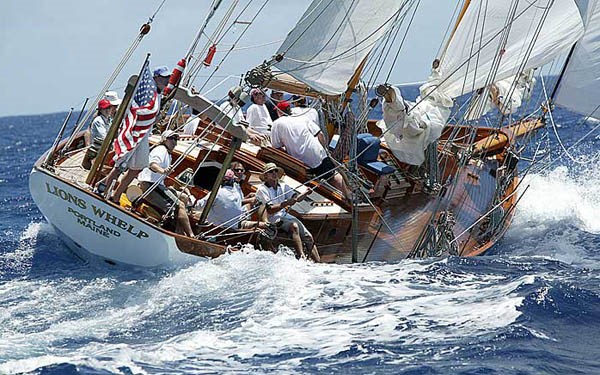
LION'S WHELP is truly a one-of-a-kind yacht. Stunningly beautiful, this traditionally lined Alden Schooner was built with cutting-edge tehchnology to the highest possible standards, making her as capable a world wide cruising vessel as possible. She has been featured in Cruising World magazine.
One of her co-owners, who runs a substantial yacht yard (Portland Yacht Services) and has done a prior circumnavigation on a schooner, sought to build or acquire another vessel capable of cruising anywhere in the world. Equally important was that she be a reasonable vessel to maintain, sail locally with a small crew, and be so carefully built and detailed in construction that her longevity would be assured. After several years of searching, an uncompleted Alden designed hull was found in California. The vessel was purchased in 1999 and brought to his own yard where the repairs warranted from the improper storage of the hull were done, the hull completed in 2001, and the balance of the construction project (decks, systems and interior) completed in 2003. As a consequence the 1986 hull number assigned belies the true age of this magnificent yacht as she really was completed in 2003.
To satisfy these discriminating owners, the yacht had to be at once capable of local cruising with a small group or cruising worldwide with a number of family members and friends. Other requirements included being able to withstand a serious grounding, collision with an ice berg or container, be so well constructed that exposure to long term structural degredation was minimized, and most importantly be a joy to be aboard. All of this and more was accomplished in her construction! Built at a cost of over $6,000,000 she would run over $8M USD to build today.
To say that the attention to detail on this vessel was intense is an understatement. In determining the hull scantlings and finish, the owners not only relied on naval architects but also studied yachts that had gone aground, examined the extent of their damage and then developed scantlings and build techniques to withstand those levels of traumatic collision or grounding. Drop tests were done on test panels to insure the hull envelope strength as a practical matter vs. relying on calculations. Much of this is evident in the hull section below where construction details are outlined.
TECHNICAL SPECIFICATIONS
ACCOMODATIONS
LION'S WHELP provides berths for up to ten - two in the "crew's quarters" forward, four in the two owner's party staterooms, three in the salon space on settee and pilot berths and one in a large (some might consider it a double) quarter berth aft. The entire interior is beautifully detailed as is the rest of the yacht. Cabinet doors are raised panel mahogany and are cored for stiffness and weight reduction. Also the bulkheads are generally raised panel and are cored as well. French & Webb, a notable Maine Yacht builder and finisher built all the doors as well as the deck furniture.
The interior is finished "Herreshoff Style" with gloss varnished mahogany trim and raised panel doors on white. The cabin sole is a semi-gloss finished Brazilian Light Cherry. All cabin sole access panels are secured fore and aft and lift out with T-handles. All of the doors, including the cabinet doors and bulkheads, are foam cored for superior panel stiffness, sound and weight reduction. Inside of the frames all exposed portions of the hull are sheathed with 5/8" tongue and groove hard pine. There is extensive 24 volt lighting throughout the yacht with numerous overhead recessed lamps, some dome style lamps, and discreetly placed fluorescent lamps providing plenty of illumination for reading at any of the berths or settees and at all of the working stations, galley, nav. station, etc. Natural light is generous as well with two very large butterfly hatches and ten opening ports as well as two fixed ports in the crews quarter's dog house. All of these openings are screened to provide an abundance of ventilation which is further complimented via the three companionways and two dorades. When ventilation alone won't provide comfort below, there is a 16,000 BTU reverse cycle air conditioning system and a 45,000 BTU diesel, circulating hot water cabin heat system wtih 4 zones.
Starting forward is the Foc'sl housing the Crew's Quarters featuring offset V-berths 6'8" in length below which there is storage in three drawers and two drop face lockers and some "bin type" storage. Additional storage is obtained via stowage hammocks strung above the berths and access to the anchor locker is in the forward bulkhead. Immediately adjoining and just aft of the Foc'sl is a small workshop with a work bench and storage for spares, fastening and the like.
Aft and through the watertight bulkhead is the owner's quarters of the yacht which encompasses two staterooms and the head and shower compartment. Forward most is the Owner's Head which features an electric Jabsco commode plumbed via a Y-valve to the holding tank, Corian vanity with undermount sink and brass hardware and good storage.
Just aft of the head is the separate Shower Compartment which drains to a separate sump with bench seat. This area is cleverly designed to incorporate private access from both owner's party staterooms and the Foc'sl.
Just aft of the head/shower compartment are the two Owner's Staterooms. These are essentially mirror image staterooms P&S. To keep the yacht as open and airy as possible, the upper half of the fore and aft bulkhead between the two staterooms drops into a pocket below, but when privacy is required is easily raised and secured. Each stateroom offers the following upper and lower berths (6'6" to port and 6'8" lengths to starboard) storage in drop face lockers below the berths and in two drawer bureaus and lockers with shelves. Above the upper berth in both staterooms is a Simrad multi display allowing those in the owner's party to check on heading, wind, depth, etc. immediately upon waking.
Next aft is the full beam Salon. To call it gracious is an understatement but it is that and more. To starboard is a large U-shaped dining settee measuring over 8'6" fore and aft and 5'6" athwartships and below which there is bin type storage. Additional storage may be found behind the seat backs and in lockers with three shelves above and outboard. At the aft bulkhead is a pass through to the galley and then further inboard is the companionway to the main deck. The lower portion of the companionway lifts to reveal the engine compartment. Dining is from a varnished mahogany pedestal table with drop leaves. Opposite the U-shaped settee is a straight settee, the back of which may be lifted to form an upper berth. As to starboard, there is storage below and behind the settee and then joinerwork above and outboard that matches that to starboard both in appearance and functionality. Aft of the settee is a very deep hanging locker and forward of the settee are a bureau with two drawers and a locker above and outboard with shelves that houses the yacht's entertainment system and there are another two large drawers further forward.
Next aft, in the walk thru to the galley, is the forward facing Navigation Station which features a flip top type chart table with book shelves outboard and all navigation and communication displays above (see electronics). Still more storage is in lockers and drawers just forward. The yacht's electrical distribution panels are adjacent to the nav. station with the 120 volt panel and the yacht's systems controls in a panel just opposite. The bench for the navigator doubles as a bench used facing aft to eat off the dinette which also has a forward facing bench seat. Both seats have storage under. Finally furthest aft on the port side there is the large quarter berth where there is some bin type storage under and additional storage in lockers and shelves above. Like the berths in the owner's cabin, this berth has a Simrad multi display immediately overhead. This berth is immediately adjacent to the companionway leading to the cockpit behind which there is access to the generator compartment and storage for the cockpit table.
Opposite the navigator's quarter berth is the aft head which features an electric Jabsco W.C. plumbed via Y-valve to the holding tank, vanity with Corian counter top and undermount sink with brass fixtures and ensuite shower system that drains via a separate sump pump. A unique feature in the head is the built in Sauna unit. The over-riding reason for its presence was treating chilled or hypothermic crew members when cruising in high latitudes, but it could be used anytime one desires.
The largest portion of the aft section of the yacht is devoted to the Galley which is U-shaped. All of the counter tops are Corian and there is a double basin undermounted Corian sink with brass fixtures. Incorporated in the countertop is a drainboard to help facilitate drying the dishes. Fixtures at the sink include a manual fresh water pump. Outboard are two large top loading refrigeration/freezer compartments which are chilled via a Grunert 230 volt/mechanical system. Cooking is done off of the Broadwater Marine 4 burner gimballed stove with oven, while re-heats are via the Kenmore microwave mounted at the forward bulkhead. Storage for foodstuffs and galley ware is ample in numerous lockers and drawers including a large pull out bin type unit under the sink.
Chelsea 6" Brass ship's clock
Teac AM/FM stereo
4 12V cabin fans
Teac Amplifier
External thermometer for refrig.
Teac 3 disk CD changer boxes
Russ Sound Controls for speakers on deck, in galley and salon
Xintex propane solenoid, sniffer
Samsung 15" flat panel TV/Computer screen
Hurricane diesel cabin heat 45,000 BTU's
2 20lb propane tanks
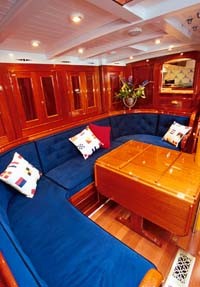
ELECTRICAL
Wired for 12 and 24 volt DC service and 120 volt AC service. A Westerbeke 10.8 kw genset handles heavier AC loads when off the dock while a 3500 watt inverter handles routine use items and is supplied off the 24 volt bank of batteries. The generator is set up with frequency controls so that the yacht can be run on European 50 cycle 230 as desired.
12/24 Volt DC
Switch panel with breakers
Amp &Volt Meters
160 Amp 3 stage 24 volt alternator
12v DC outlets
675ah wet cell 24 volt batt in two banks
2 Group 31 Genset & engine start battery & navionics battery
24volt/12volt charger
130 Volt AC
Switch panel with breakers
Amp &Volt Meters
Frequency meter
Outlets
2 100 amp 24 volt Mastervolt battery chargers
Allcraft hot water heater (also eng. Supplied)
Isolation transformer
3500 amp Mastervolt Inverter
10.8 KW Westerbeke genset
Genset equipped with 12volt alternator
Generator equipped with 50cycle/60 cycle smart switch
ELECTRONICS
All electronics are located at the Navigation Station, including a second control for the autopilot. There are repeaters of the Simrad Multi display located at the navigator's quarter berth, and over the berths in the P&S owner's quarters staterooms. A full suite of Simrad repeaters is located in the cockpit as is the Autopilot control and there is a seconnd Simrad VHF located in the helm seat, also a Radar/Plotter repeater is carefully positioned so as not to intrude on the traditional appearance of the cockpit. The Simrad chart displays are linked to an IBM computer running Nobletec software with charts from the Canadian Maritimes through the Carribbean. The computer is equipped with a server and 2 hard drives providing complete back up of all charts etc.
Iridium Sat Phone
Inmarsat "c" fisheries sat phone
(2)Simrad RS87 DSC VHF
Sea 857 Hailer/Fog signals
Icom M710 SSB
(5)Simrad Multi Displays
(2)Simrad Digital Compass
(2)Simrad Wind Pt. &Speed
(2)Simrad Depth
(2)Interphase forward looking depth/sonar
(2)Simrad Robertson AP20 Autopilot
Simrad DS44 cockpit chart/radar display
Simrad CA44 Radar/Chart display at nav. Station
"Seame" radar transponder
ACR 406 mhz EPIRB
MECHANICAL
The Perkins 6.354 diesel turns a 24" 3 blade Max prop set at 22 degrees of pitch on a 1-1/4" stainless shaft through a 2:1 reduction gear and Aquadrive coupling; equipped with two water lift and one water drop mufflers and a well insulated engine compartment, the yacht is so quiet that the engine can only marginally be heard in the galley and salon and is not at all audible on deck. Dry exhaust with the gases in a specially fabricated insert running up the mainmast with no diesel smell anywhere.
Fuel: There are three fuel tanks, two 60 gallon storage tanks feeding an 80 gallon day tank through dual Racors; there is then a single Racor between the day tank and the engine/genset as well as the secondary fuel filter on the machinery itself. "Low cruise" of 6.5 to 7 Kt. in smooth ot moderate conditions burning 2 Gal. Per hour with the generator and a high cruise of 8 knots burning 2.8-3.2 GPH with Genset running. Feul capacity was sized around powering from Newport to Bermuda (650 miles) in light air.
Extensive dewatering equipment, see list below(again, the yacht was intended to be very self sufficient). Sea Recovery watermaker
Kobelt engine controls
Edson worm gear type steering
Evolution type line cutter
Machinery Space Halon System
Dual/single racor on engine see disc.
Spare Max Propellor
PYI Dripless shaft seal
16,000 BTU Rev. Cyc Air Conditioning
45,000 BTU Diesel circulating hot water cabin heat; 4 zones
2 jabsco Electric bilge pumps
Manual Edson gusher type pump
Piranah Elect emergency 380 GPM bilge pump
Jabsco engine driven 60 GPM bilge pump
2 Groco holding tank level monitors
Tank Sentry Fuel & Water tank level monitors
Sea Recovery watermaker 800 GPD
Allcraft all stainless 12 gal. hot water heater
4 Grunert 230 volt/mechanical refrigeration plates
HULL & DECK
Fiberglass sheathed cold molded and strip planked hull finished with white Epifanes Nautifort multi season finish; green boot top, and bottom finished with one coat of copper epoxy and then in Micron 66 ablative red antifouling.
Construction is nothing less than impressive! This particular hull was selected by the owners who had studied hull failures of yachts that had gone through collisions and groundings in order to better develop a hull that could withstand a casualty and well survive when at long distances from full service yards. Prior to commencing the project, a test section of hull was built up and then run through a drop test. A 5' section of steel railroad rail weighing 170 lbs was dropped from 30' onto the panel-imagine the force! The test was done multiple times and in each case the rail, dropped on end, only dented the panel! Other considerations in the choosing of this hull was righting moment and maximum angle of positive righting arm: in completing the design work and building the hull a maximum righting arm of 74,000 pounds was achieved and her range of positive stability is 145%! Part of that is her 30,000 pounds of ballast with stainless steel keel bolts, on a dry weight hull of 74,000 (84,000 is her full displacement with fluids and gear onboard.)
Starting at the outer skin and continuing on to the innermost skin LION'S WHELP is built as follows: two layers of 10 oz. fiberglass in vinylester resin, four layers of cold molded in epoxy, Wester Red Cedar totaling 1" thickness, strip planked Alaskan Yellow Cedar on laminated 3"x3" Alaskan Cedar Frames. Next is a layer of 18/8 fiberglass cloth and then between the frames the bays are filled with 3" thick Nidacore sealed to the frames on all edges, interior of the Nidacore is a layer of 18/8 fiberglass cloth in vinylester resin and then finally 5/8" hard pine tongue and groove ceilings.
Attention to detail throughout to insure minimal opportunity for water to do its damage and to create an incredibly strong yacht is impressive, please note some of the details: 1. Exquisite care was taken on all of the limber holes to insure proper drainage, 2. Passivated stainless steel mast steps and floor frames fastened in with monel fastenings - these tie into stainless steel doublers on all the frames. To insure a perfect fit, a full template was built of each section before fabricating the stainless work. A stainless I beam has been incorporated into the floors and frames/mainmast step and is over 7' in length to best spread the load from this spar. 3. At all through hulls the openings were "overcut" and full depth cedar rings were built up and installed, between the cedar rings and the through hull a further level of protection was made by installing a full depth section of G-10 tubing. 3. On centerline from keel to stem a heavy layer of Kevlar cloth set in epoxy was applied 8" either side. While there are more discharges, to minimize hull opening there are just two sea chests for raw water intakes. 4. Special stainless bow sprit support so that should the bobstay ever fail, the heel of the sprit won't jacknife into the fore deck. These are just a few of the details.
The decks and houses are no less well thought out or robustly built. The deckhouses, butterfly hatches etc. are built of a solid teak interior, 5/8" plywood center and then solid teak exterior. The intent was to make them as strong as they are beautiful. Many solid wood, or for that matter, fiberglass deck houses have cracked when hit by a large sea. This simply will not happen here. At the join of all of the coamings, deck houses, covering boards etc. to the deck there is a radius built in to prohibit water laying there and doing any damage. All of the bulwarks, covering boards, cap rails and deck houses are finished in Epifanes spar varnish. Most of these houses, cockpit etc. were fabricated by French & Webb, a highly regarded yacht builder here in Maine.
The decks are teak by Teak Decking Systems and are a three layer 3/4" teak laminate over two 9mm layers of mernati that are epoxied and screwed together then 3/4" of cellutex foam core. In way of the covering boards there is extremely rot resistent Alaskan Red Cedar vs. the Meranti. The decks and house tops are on Alaskan Yellow Cedar beams.
There is a large comfortable cockpit that can easily seat eight and large storage/sail locker to starboard, steeple type brass binnacle on a teak pedestal. A good sized lazarette is on the aft deck providing additional storage and the shore power connection is discreetly hidden in this location. Expansive teak side decks provide ease of access about the rest of the yacht.
Custom Muir 4500 bronze windlass
12 P Fds
100 lb Danforth with 400' 1/2" HT chain
2 Horseshoe Liferings
200 lb Luke storm anchor with chain & rode totaling 1000' in 2 Sect.
Man overboard pole
2nd 100 lb Danforth
Viking 8 man liferaft
Anchor wash down plumbed into hawse
Flare kit
Fresh water wash down aft
Bell
Double stainless steel lifelines with gates P&S
4 3lb. ABC dry chem fire ext.
Deck Canvas (Sunbrella)
1 5lb Halon fire ext.
Storm covers for all hatches
Covers for deck boxes and Foc'sl
Bow sprit cover
Bimini for cockpit
Dodger
Wheel & Binnacle cover
Varnished teak staff & Ensign
All bronze deck hardware
10 1/2' Cape Dory yacht tender
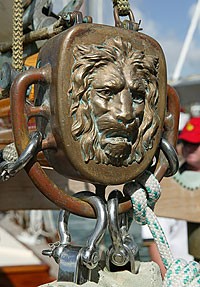
LION'S WHELP was finished by a member of one of New England's longest term and most knowledgeable yachting families. Absolutely no expense was spared in her construction and all work was done to the highest standard possible. Every single construction detail and material was chosen to insure the long term durability of the yacht.

